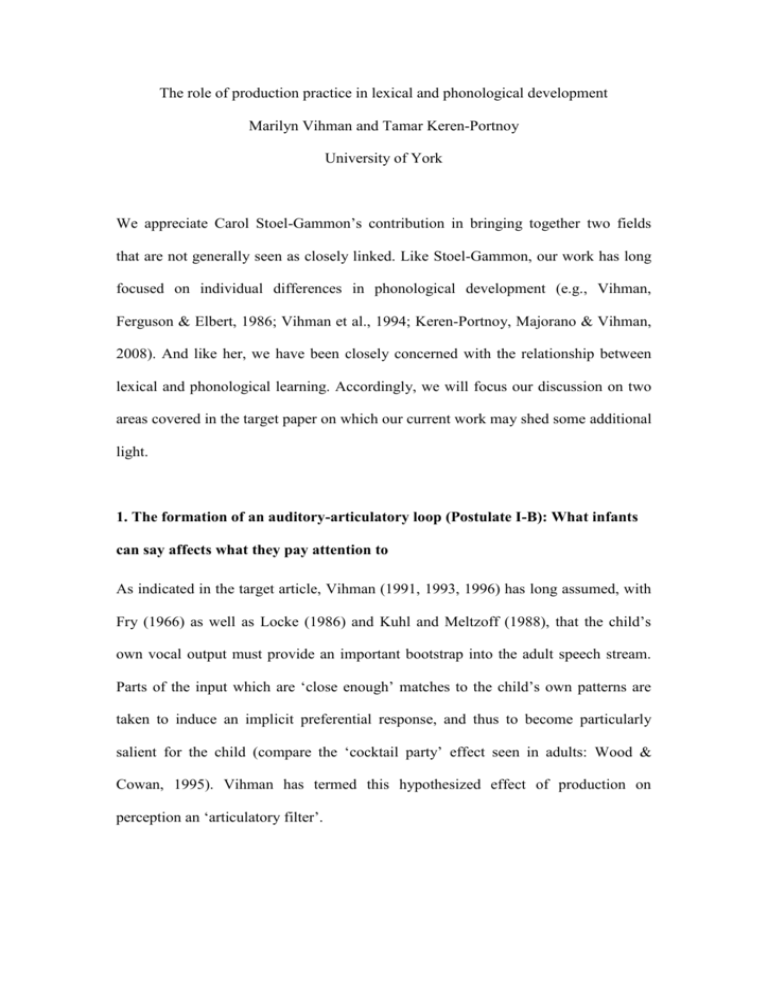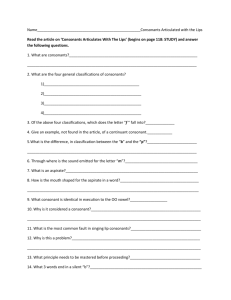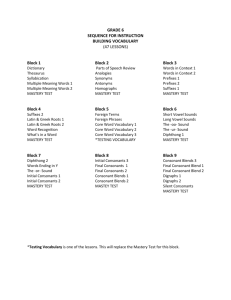Stoel-Gammon: Relationships between lexical
advertisement

The role of production practice in lexical and phonological development Marilyn Vihman and Tamar Keren-Portnoy University of York We appreciate Carol Stoel-Gammon’s contribution in bringing together two fields that are not generally seen as closely linked. Like Stoel-Gammon, our work has long focused on individual differences in phonological development (e.g., Vihman, Ferguson & Elbert, 1986; Vihman et al., 1994; Keren-Portnoy, Majorano & Vihman, 2008). And like her, we have been closely concerned with the relationship between lexical and phonological learning. Accordingly, we will focus our discussion on two areas covered in the target paper on which our current work may shed some additional light. 1. The formation of an auditory-articulatory loop (Postulate I-B): What infants can say affects what they pay attention to As indicated in the target article, Vihman (1991, 1993, 1996) has long assumed, with Fry (1966) as well as Locke (1986) and Kuhl and Meltzoff (1988), that the child’s own vocal output must provide an important bootstrap into the adult speech stream. Parts of the input which are ‘close enough’ matches to the child’s own patterns are taken to induce an implicit preferential response, and thus to become particularly salient for the child (compare the ‘cocktail party’ effect seen in adults: Wood & Cowan, 1995). Vihman has termed this hypothesized effect of production on perception an ‘articulatory filter’. In a first attempt to demonstrate this mechanism experimentally Vihman and Nakai (2003) made bimonthly recordings of children learning either English (N = 27) or Welsh (N = 26) in North Wales over a period of two months. Two weeks after the final recording session the infants were tested using the head-turn preference procedure (HPP) on lists of nonwords that featured one of two consonants of comparable input incidence but likely contrasting frequency in infant production (/s/ vs. /t/ for English, /g/ vs. /b/ for Welsh). A significant novelty correlation was obtained for the English infants only, such that the more a child produced [t] or [d], the more they attended to /s/ (p < .01). A later reanalysis of the data showed that the effect derived from a subset of the infants who produced over 200 [t] or [d] tokens over the course of the four recording sessions (DePaolis, Vihman, Nakai & Lum, in revision assuming this is under review, the current APA format is “Manuscript submitted for publication”). In a finer-grained subsequent study DePaolis (2006) tested the effect of well-practiced consonants on children’s attention to nonwords embedded in short sentences rather than to nonword lists. Infants were recorded every week or two until they showed mastery of at least one supraglottal consonant (Vihman, DePaolis & Keren-Portnoy, 2009; DePaolis, Vihman & Keren-Portnoy, under review). They were then tested, again with HPP, on contrasting passages of five simple sentences with one or two content-word slots filled with nonwords made up of repeated uses of (a) a stop consonant that child was using to criterion (disregarding voicing distinctions – e.g., bapeb), (b) another child’s high-use consonant (e.g., deeted), or (c) the fricatives /f/v/, which are seldom used in this period (e.g., vufev). In this experiment we discovered the importance of rapidly testing the children after identifying their high-use consonant: Nine of the 18 children tested had only a single such consonant, as planned; of those nine children, six showed greater attention to the passages featuring the preferred consonant, although the effect did not reach significance. Of the remaining nine, whom we were unable to test before they showed mastery of more than one consonant, all but one showed the reverse pattern, greater attention to the passage featuring stops they were not yet producing frequently than to the other stop passage (p=.04) – a repeat of the novelty effect seen in Vihman & Nakai (2003). The groups did not differ in their response to the fricative passages. Thus, extent of prior use of a particular consonant had a measurable effect on perceptual attention to that consonant, as predicted – but the effect was consistent enough to result in a significant effect only in the case of children with more production experience, or at least with demonstrated mastery of more than one consonant. Returning to the target article, it is important to note that there is no reason to think that the effect that we have captured experimentally is evidence of awareness on the part of the infants; it is, as we understand it, a wholly implicit response to the sounds of input speech (or ‘tacit knowledge’, in Stoel-Gammon’s words), mediated by the child’s own production practice. The following sentence is *very* long – think about breaking it up to make the logic clearer. To date, we have succeeded only in showing that infants will listen with greater attention to consonants not yet well established in their production repertoire (the test consonants were always stops, which all tend to be mastered within the single-word period). However, we remain optimistic that future studies, with larger samples of children seen frequently and tested with a minimum of delay, will show a basic effect of salience (within the fast-moving speech stream) of those sound patterns with which the child has become familiar through vocal practice. 2. Vocal practice affects word learning and phonological memory In a longitudinal study of 20 American infants McCune and Vihman (2001) found a significant effect of consonant mastery on age at use of referential words. We have replicated this effect in two studies, one with 12 British children seen from 11 months to the end of the single word period in North Wales (Keren-Portnoy et al., 2005), the other with 59 British children followed from age 9 to 18 months in Yorkshire. Age at onset of frequent and consistent use of a second consonant over two or more sessions was a strong predictor of age of first word use in both groups. In a subsequent investigation of the effect of vocal practice on phonological memory we carried out a longitudinal study of 12 one-year-olds from 11 months to age two, again combining observational and experimental methods (Keren-Portnoy et al., in press). The results demonstrated that earlier mastery of two consonants was strongly correlated with children’s scores on a nonword test at age two (p = .002; the nonwords derived from Roy & Chiat, 2004). To test the more specific hypothesis that consonants well established in a child’s repertoire would support better performance on nonword repetition we developed nonwords (one or two syllables long) made up of consonants that were or were not used frequently in each child’s productions, based on a recording made shortly before the test (close to age two). Here again we had positive results: significantly higher mean score than OUT IN words had a words (p = .01), with 9 out of 15 children showing the effect. In addition, we found that for those nine children who were better at repeating IN than OUT nonwords, the proportion of ‘whole-word errors’ – or errors suggesting a spreading of the difficulty from the unfamiliar consonants to the entire word, thus also affecting vowels and syllable shape – tended to be higher for OUT nonwords (p = .06). Finally, we found that familiar real words were repeated significantly more accurately than the IN nonwords (p = .02), despite the fact that some of those words contained consonants that were not well established in a given child’s repertoire. We explored this somewhat paradoxical finding further, classifying the specific consonants in each familiar word as well as in each nonword as IN or OUT; we then calculated whether there were fewer errors for words than in the novel accurate renditions of IN OUT IN consonants in familiar real nonwords, and conversely, whether there were more consonants in familiar real words than in the OUT nonwords. The result was in accord with the hypothesis that, regardless of the child’s relative experience with a particular consonant, familiarity with a word as a whole facilitates repetition (10 out of 15 children showed the predicted effect). To summarize the findings of this study, we found that production experience does indeed support is a stronger verb appropriate here, e.g., ‘improves’ or ‘facilitates’? phonological memory. More specifically, we found that the length of time over which a child has been producing consonants correlates positively with success in nonword repetition, the usual index of phonological working memory (e.g., Gathercole, 2006). In addition, the quality of phonological memory is superior for more familiar material – whether consonants or whole words. This suggests that memory for sound patterns develops along with advances in consonant production, with size of lexicon a likely mediating factor – as suggested in the target article. Can these results tell us something about representation, or do they reflect mere articulatory development or maturation? Note that regular, repeated substitutions (such as /s/ stopping), which likely reflect articulatory difficulty, were not counted as errors here. Only cases in which a child replaced a target segment by different segments in different (non)words were considered errors, as this was taken to reflect problems in the identification or categorization of sounds rather than in production per se. In addition, we concluded that the fact that both IN and OUT consonants were more successfully produced in the real words indicates that, alongside articulation of specific segments, experience with sound sequences also affects relative difficulty for the child. These results add to the findings cited in the target article, which show that production accuracy in children is linked to frequency. Our study investigated one little studied aspect of this, namely, the effects of frequency of occurrence of segments in individual children’s own productions. We agree with Stoel-Gammon that the effects of frequency on children’s word learning should be investigated with attention not only to input, nor only to groups of children, but to output data and to effects at the level of individual children. References DePaolis, R. A. (2006). The influence of production on the perception of speech. In Bamman, D., Magnitskaia, T. & Zaller, C. (eds.), Proceedings of the 30th Boston University Conference on Language Development. Somerville, MA: Cascadilla Press. DePaolis, R. A., Vihman, M. M., Nakai, S. & Lum, J. (in revision). The influence of babbling patterns on the perception of speech. DePaolis, R. A., Vihman, M. M., & Keren-Portnoy, T. (under review). The effect of production patterns on the processing of speech in prelinguistic infants. Fry, D. (1966). The development of the phonological system in the normal and deaf child. In F. Smith & G.A. Miller (eds), The genesis of language, 187-206. Cambridge, MA: MIT Press. Gathercole, S. E. (2006). Nonword repetition and word learning: The nature of the relationship. Applied Psycholinguistics, 27, 513-543. Keren-Portnoy, T., Vihman, M. M., & DePaolis, R. A. (2005). Output as input: Effects of production practice on referential word use. Paper presented at the Xth International Congress for the Study of Child Language, Berlin, Germany. Keren-Portnoy, T., Majorano, M. & Vihman, M. M. (2008). From phonetics to phonology: The emergence of first words in Italian. Journal of Child Language, 36, 235-267. Keren-Portnoy, T., Vihman, M. M., DePaolis, R., Whitaker, C. & Williams, N. A. (in press). The role of vocal practice in constructing phonological working memory. Journal of Speech, Language and Hearing Research. Kuhl, P.K. & Meltzoff, A.N. (1988). Speech as an intermodal object of perception. In A. Yonas (ed.), Perceptual Development in Infancy, pp. 235-266. The Minnesota Symposia on Child Psychology, 20. Hillsdale, NJ: Lawrence Erlbaum. McCune, L. & Vihman, M. M. (2001). Early phonetic and lexical development. Journal of Speech, Language and Hearing Research, 44, 670-684. Locke, J. L. (1986). Speech perception and the emergent lexicon: An ethological approach. In P. Fletcher & M. Garman (eds.), Language Acquisition: Studies in First Language Development (2d ed.). Cambridge: The University Press. Roy, P. & Chiat, S. (2004). A prosdically controlled word and nonword repetition task for 2- to 4-year olds: Evidence from typically developing children. Journal of Speech, Language, and Hearing Research, 47, 223-234. Vihman, M. M. (1991). Ontogeny of phonetic gestures: Speech production. In I.G. Mattingly & M. Studdert-Kennedy (eds.), Modularity and the Motor Theory of Speech Perception. NY: Lawrence Erlbaum Associates. Vihman, M. M. (1993). Variable paths to early word production. Journal of Phonetics, 21, 61-82. Vihman, M. M. (1996). Phonological Development. Oxford: Basil Blackwell. Vihman, M. M., DePaolis, R. A. & Keren-Portnoy, T. (2009). A Dynamic Systems approach to babbling and words. In E. Bavin (ed.), Handbook of Child Language (pp. 163-182). Cambridge: Cambridge University Press. Vihman, M. M., C.A. Ferguson & M. Elbert. (1986). Phonological development from babbling to speech: Common tendencies and individual differences. Applied Psycholinguistics, 7, 3-40. Vihman, M. M., Kay, E., Boysson-Bardies, B. de, Durand, C. & Sundberg, U. (1994). External sources of individual differences? A cross-linguistic analysis of the phonetics of mothers' speech to one-year-old children. Developmental Psychology, 30, 652-663. Vihman, M. M. & Nakai, S. (2003). Experimental evidence for an effect of vocal experience on infant speech perception. In M. J. Solé, D. Recasens & J. Romero (eds.), Proceedings of the 15th International Congress of Phonetic Sciences, Barcelona (pp. 1017-1020). Wood, N. & Cowan, N. (1995). The cocktail party phenomenon revisited. Journal of Experimental Psychology: Learning, Memory, and Cognition, 21, 255-260.








